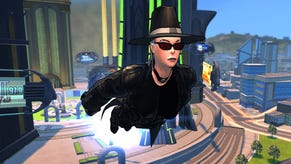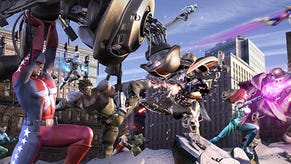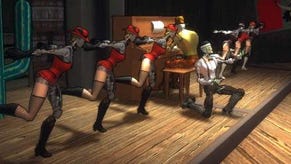They Are The Champions Online: The Game's Afoot
Los Gatos is the Beverly Hills of The San Francisco satellites. It's not just home of people who really fancy a posh ZIP code, however. It's also Cryptic Studios' base. The veterans of the City of Heroes games are giving their first, real public showing of now-to-be-2K-distributed Champions to a selected band of gentlemen of the press. For some reason, I was invited. Spooks.
Since I've interviewed anyone who didn't actively run away from me, I've a whole week of content to amuse you. But let's start a little more general than that. Here's an Jack Emmert and John Needham quote-packed overview of their action-influenced take on the MMO game, Cryptic's love of the Champions pen-and-paper RPG, the tranquil-yet-troublesome expanse of Monster Island and what they have planned after Champions...
John Needham, formerly of Sony Online Entertainment, has only been with Cryptic for a month but talks gregariously about where they're heading next. While the co-console development isn't quite so interesting to RPS – though the possibility that Champions will share servers between the 360 and the PC does intrigue – it's the next generation of Cryptic's love of user-freedom which appeals. “Looking beyond Champions, we've got a lot of great tech in development here,” says Needham, “We've got a dynamic content system which allows us to spawn unique zones, on the fly – completely unique zones. We think that's going to give gamers unlimited content in our future games to explore.”
“We're also taking all our development tools, polishing them up and then we're going to give them out to gamers in the future – let them make the content in our worlds that they want to play... along with thousands of others,” he says, “You're not going to see these features in Champions – but they're in development and one of the great things this company does is to take all the systems they develop, put them into the core and then push them out to all their games. These are systems that you could potentially see in Champions in the future.”
Which, while exciting, strikes us as an odd note to start their demonstrations with – getting us excited about games in the future, where there's still things to be excited about in Champions. Perhaps the thing which makes us most secure in our excitement is, that after having witnessed another string of questionable MMO launches recently, is how this one is fundamentally playable already. When touring around the airy offices, Jack Emmert, Cryptic's outspoken chief Creative Officer, points out a thermometer graph on the wall of the latest intensive all-of-Cryptic playtesting session. The challenge was for them to play six-hundred hours of the game in the period. Succeed, and they'd receive a barbecue party from the founders as a reward. Within the few weeks in question, they actually managed over 800.
Champions is a game which appeared out of necessity. When their work on the Marvel MMO fell through, as a company, they were left at a loose end. “We had to look around and decide what we wanted to do next.... but what should we do?” says Emmert. “Well, my argument to my fellow founders was very simple – we're prepared to make a next-gen superhero game. Let's not stop. Let's pick up the IP for Champions and go forward with it. It's something which has name-recognition with the geek community and it's a wonderful IP to play with. It's got everything that we need to be able to create a AAA superhero product”
Which, from a traditional vidoegames perspective, may seem somewhat unexpected. Champions' only interaction with videogaming was an ambitious if abortive mid-nineties attempt, mainly known as a fermenter – along with Bullfrog's cancelled Indestructibles - of the no-workable-original-superhero-game myth which floated around until City of Heroes and Freedom Force destroyed it.
However, Cryptic is a company that has its intellectual roots clearly in the world of table-top gaming. We pass through a room where ranks of figures and half-played games of Warhammer 40,000 and Warmachine await gamers' return (Emmert's Tau was losing to Eldar, for the record). And – specifically - Champions was fundamentally influential on Jack's development. “I particularly played Champions a lot when I was younger – it formed one of the inspirations for City of Heroes, along with all the comic books I'd read. To me, it was just as important as Marvel or DC or anything else.”
Cryptic were convinced. They liked the IP so much that they bought it outright from owners Hero games, who now produce Champions games under license from Cryptic. Hero Games' Steven S. Long is even present, showing the first post-Cryptic sourcebook of Monster Island, which includes pen-and-paper statistics for all the creatures of one of the game's areas.
And, funnily enough, it's also the setting which Cryptic use to showcase the game and demonstrate its approach. Visually, as the screenshots show, they've gone for a look that, while it shares some characteristics with cell-shading, hasn't completely capitulated to the cartoonish. And there's that sense of the place, where they've turned years of RPG history into a coherent games world.
The advantage of buying an RPG setting that's been existent for nearly thirty years is that there's a lot of material to use which you don't have to dream up. “During the 1970s, one of the races tried to attack earth with a lot of giant monsters,” explains Emmert, “and this is where we keep them.” We're flown across the boneyard where they go to die, past a volcano – which erupts every ten minutes or so, forcing people on the island to dodge falling lava, past the sinister organisation VIPER trying to hatch an enormous egg, and the out-of-control corporation Argent who run a Hunting Lodge for people who want to go one-on-one with a big ol' dino. It's a couple of miles square of area, which is designed to house about hundred players at once.
There's also enormous creatures for you to beat on, ideally in groups. As in, players in groups. If the giant monsters were in groups, it could be as messy as Gozilla's Tokyo pubcrawl with his booze-addled mates. As the combat demonstration starts, we're introduced to a couple of 'em. The best is the enormous flaming ape, going by the Simpsons-homaging name of Qwjibo. Emmert describes going with the ape-idea to the artist, who came back with an exclamation of “It would make him cooler if he was on fire!” Artists do not think like us. Artists are also not always wrong.
But to actually show off the detail of combat, we go in closer, with our hero fighting beast-people, very much in the Dr Moreau fashion. Which is appropriate, as this zone is actually presided over by a descendant of the in-public-domain Victorian proto-sci-fi character.
While there are obvious similarities to City of Heroes, there's a strong influence from console titles like Marvel: Ultimate Alliance and God of War. For example, rather than an simple exchange of attacks, there's an increased use of “tells”. So if an attack is lining up on you, they'll telegraph the blow, demanding you turn to a block move to avoid the worst of the attack. Simultaneously, there's an adrenaline style link between your attacks – your lowest ones will build up an energy bar, while the more powerful and useful attacks will spend the attack. The tactical decision of when to build and when to spend is of crucial importance. You can also do things like lob bits of the scenery at the enemy, because you are, after all, a super-fellow. Enemies go further into AI routines than in COH – as well as a larger gent with the telegraphed knock-out attack, we see ratmen summoning reinforcements, because they're bloody cowards. Growls!
That said, despite all the action tropes, it's still primarily a role-playing game. “I wouldn't say it's 50:50 – the RPG is predominant,” says Emmert when asked, “but there's more of an element of skill than in City of Heroes”. Those who were hoping a return to the early days of City of Heroes are going to be disappointed – a hero will be facing down around three to four henchpeople a piece, and increasingly few as the power levels climb.
Then there's the arch-villains, one of the game's main features, and one on which Cryptic remain cryptic. It's part of the creation system, where rather than tying your abilities to a class, you get to mix and match power-sets according to your whim (they claim to have a unique way of balancing it, but aren't ready to make it public). The archvillain is your dark mirror, created at the same time you make your hero, and turns up at central points in the game. However, there's clearly more to than that – when pressed, Emerret describes how your villains will be appearing randomly in the world, adding more variety than the Cryptic-created content.
It also ties into the Player Versus Player combat in some way. Emmert says that you always start by creating a hero, and the Nemesis system links to the PvP: “How the players accesses that archvillain and how do they control it?” He leaves it hanging, but it's easy enough to speculate. Generally speaking, the lessons of City of Heroes are obvious. “My belief is that you have to have [PVP] in the game at launch if you're going to do it,” says Emmeret, “and you have to have it be completely optional, as there's a whole bunch of people who don't want to touch it”.
The other immediately noticeable thing in the game is the introduction of a few more storytelling elements. City of Heroes was a uniquely atmospheric MMO – civilians telling me how awesome I am was something I dearly missed when I left Paragon City's spandexed-streets – and they're including elements like minor cut-scenes to enhance that. “Playing the game should feel like reading a comic book,” says Emmeret, “We're investigating ways to make it feel as if every adventure you do feels like working your way through a comic book adventure.”
And RPS' comic book games-journalism adventure will continue all next week, when we'll interview Jack Emmeret, have lunch with Lead Designer Randy Mosiondz, talk about the origins of Champions with original designer (and SSI veteran) George MacDonald and have Shayne Herrera rant about exactly how they're going to top the City of Heroes character creator (which is the only time I've ever earnestly asked “Can I make my head enormous” to a developer). Oh, and we'll be giving away a Champions skateboard minus the wheels, because I feel like an Emo-Silver Surfer with it lying around my house.
So come back for that, eh?










